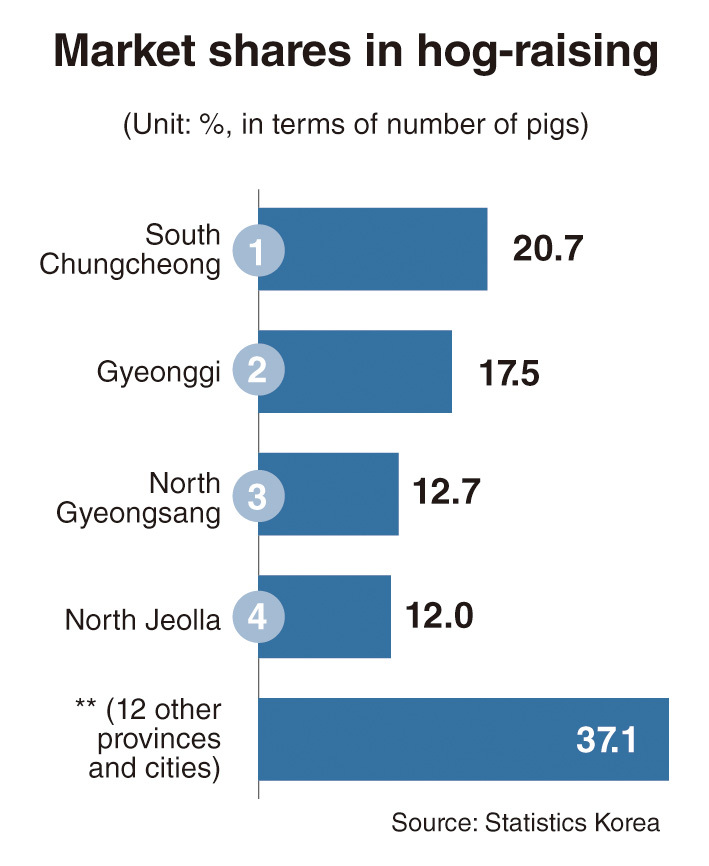[News Focus] Hog-raising industry alarmed by spread of swine fever
Hog farms are in every part of S. Korea, except Seoul
By Kim Yon-sePublished : Oct. 8, 2019 - 12:00
SEJONG -- It is now close to one month since the nation’s first case of African swine fever was confirmed in Paju, Gyeonggi Province, on Sept. 17.
The number of outbreaks of the deadly animal virus came to 13 as of 4 p.m., Oct. 8 -- eight in Gyeonggi Province and five in Incheon. All the affected regions are close to the inter-Korean border: Paju, Gyeonggi Province, with five cases; Yeoncheon, Gyeonggi Province, with one case; Ganghwa County, Incheon, with five cases; and Gimpo, Gyeonggi Province, with two cases.
While there have been suspected cases in six other locations, all the pigs there tested negative for the virus. Those cases occurred in Yangju, Hwaseong and Pocheon, all in Gyeonggi Province; Ongjin County, Incheon; and Hongseong and Boryeong, South Chungcheong Province.
According to the Ministry of Agriculture, Food and Rural Affairs, 145,546 pigs at 89 farms in Paju, Yeoncheon, Gimpo and Ganghwa have been culled so far.
The number of outbreaks of the deadly animal virus came to 13 as of 4 p.m., Oct. 8 -- eight in Gyeonggi Province and five in Incheon. All the affected regions are close to the inter-Korean border: Paju, Gyeonggi Province, with five cases; Yeoncheon, Gyeonggi Province, with one case; Ganghwa County, Incheon, with five cases; and Gimpo, Gyeonggi Province, with two cases.
While there have been suspected cases in six other locations, all the pigs there tested negative for the virus. Those cases occurred in Yangju, Hwaseong and Pocheon, all in Gyeonggi Province; Ongjin County, Incheon; and Hongseong and Boryeong, South Chungcheong Province.
According to the Ministry of Agriculture, Food and Rural Affairs, 145,546 pigs at 89 farms in Paju, Yeoncheon, Gimpo and Ganghwa have been culled so far.

Though the disease has yet to spread to the southern or eastern parts of the country, possibly due to an aggressive state-led sanitization program, quarantine authorities have yet to find the point of origin or route of transmission.
Some experts have raised the possibility that the virus, which causes a highly contagious hemorrhagic fever in pigs, could have spread to domesticated pigs from wild boars from North Korea, where a case of ASF was reported in May.
The virus was detected in a wild boar found dead Oct. 2 in the Demilitarized Zone in Yeoncheon.
Some hog-raising industry insiders have suggested that the virus may have spread to other locations in northern Gyeonggi from the farm in Paju where the first case was reported via fomites such as farm equipment and transportation trucks.
Gimpo and Ganghwa are located west of Paju, and Yeoncheon is located east of Paju. All these areas are close to the southern part of North Korea, not far from the city of Kaesong and the counties of Kaepung and Changpung.
The National Intelligence Service stated in a Sept. 24 report to the National Assembly that it had evidence of a series of ASF outbreaks across North Korea since July.
The North is reportedly taking a lukewarm stance toward the South’s suggestion that the two sides work together to prevent epidemics.
African swine fever has a 100 percent mortality rate for infected pigs, but doctors and veterinarians say it cannot infect humans.
Though government officials clarified that cooked pork would present little risk even if the pigs had the virus, recent outbreaks affected pork prices. Consumer pork prices climbed 6.5 percent on-year (and 4.9 percent from a month earlier) to trade at 21,560 won ($18) per kilogram as of October 7.
Given the virus’s incubation period, which ranges from a week to 19 days, there is an urgent need to prevent contagion to farms in the southern and eastern Gyeonggi communities of Hwaseong, Pyeongtaek, Osan, Anseong, Yongin, Icheon and Yeoju.
Market insiders are issuing alarm bells, saying the hog-raising industry in South Korea might collapse altogether if the disease continues to spread through Gyeonggi and into neighboring provinces.
An official from the Agriculture Ministry said local governments had already taken protective measures to disinfect farms and farm equipment over the past three weeks.
According to Statistics Korea, South Chungcheong Province led the country in terms of the number of hogs raised as of the third quarter of last year, with 2.41 million or 20.7 percent of the nationwide total. Gyeonggi Province was next with 17.5 percent (2.04 million), followed by North Gyeongsang Province with 12.7 percent (1.47 million). The three accounted for 50.9 percent of the nationwide total of 11.64 million.

North Jeolla was No. 4 with 12 percent (1.39 million) and South Gyeongsang was No. 5 with 11 percent (1.28 million).
The data also showed that there were 6,196 hog farms nationwide. In terms of the number of farms, Gyeonggi Province topped the list with 1,245, followed by South Chungcheong with 1,139 and North Jeolla with 802.
South Gyeongsang Province was No. 4 with 705 farms, trailed by North Gyeongsang with 699, South Jeolla with 546, North Chungcheong with 341, Jeju with 286 and Gangwon with 264. Meanwhile, North Chungcheong Province has the highest concentration of slaughterhouses, notably in Jincheon and Eumseong counties.
Of the nine provinces and eight major cities including Sejong and Busan, 16 regions had hog farms -- all except Seoul. Veterinarians warn of the dire scenario that could occur if a second series of outbreaks occurred in the southern part of the country.
In China and Vietnam, initial outbreaks of African swine fever were followed by momentary lulls, with few cases seen for days or weeks at a time. However, over several months, the virus spread to many regions within both countries.
By Kim Yon-se (kys@heraldcorp.com)


![[Herald Interview] 'Amid aging population, Korea to invite more young professionals from overseas'](http://res.heraldm.com/phpwas/restmb_idxmake.php?idx=644&simg=/content/image/2024/04/24/20240424050844_0.jpg&u=20240424200058)















![[Today’s K-pop] Kep1er to disband after 2 1/2 years: report](http://res.heraldm.com/phpwas/restmb_idxmake.php?idx=642&simg=/content/image/2024/04/25/20240425050792_0.jpg&u=)